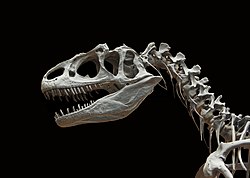User:Abyssal/Prehistory of North America
{ {{Portal maintenance status|date
IntroductionSelected article on prehistoric North America
Styracosaurus (/stɪˌrækəˈsɔːrəs/ stə-RAK-ə-SOR-əs; meaning "spiked lizard" from the Ancient Greek styrax/στύραξ "spike at the butt-end of a spear-shaft" and sauros/σαῦρος "lizard") was a genus of herbivorous ceratopsian dinosaur from the Cretaceous Period (Campanian stage), about 75.5 to 75 million years ago. It had four to six long horns extending from its neck frill, a smaller horn on each of its cheeks, and a single horn protruding from its nose, which may have been up to 60 centimetres (2 ft) long and 15 centimetres (6 in) wide. The function or functions of the horns and frills have been debated for many years.
Styracosaurus was a relatively large dinosaur, reaching lengths of 5.5 metres (18 ft) and weighing nearly 3 tons. It stood about 1.8 meters (6 ft) tall. Styracosaurus possessed four short legs and a bulky body. Its tail was rather short. The skull had a beak and shearing cheek teeth arranged in continuous dental batteries, suggesting that the animal sliced up plants. Like other ceratopsians, this dinosaur may have been a herd animal, traveling in large groups, as suggested by bonebeds. Named by Lawrence Lambe in 1913, Styracosaurus is a member of the Centrosaurinae. One species, S. albertensis, is currently assigned to Styracosaurus. Other species assigned to the genus have since been reassigned elsewhere. (see more...) Need help?Do you have a question about Abyssal/Prehistory of North America that you can't find the answer to? Consider asking it at the Wikipedia reference desk. Selected article on the prehistory of North America in science, culture and economicsThe Bone Wars is the name given to a period of intense fossil speculation and discovery during the Gilded Age of American history, marked by a heated rivalry between Edward Drinker Cope and Othniel Charles Marsh. The two paleontologists used underhanded methods to out-compete the other in the field, resorting to bribery, theft, and destruction of bones. The scientists also attacked each other in scientific publications, attempting to ruin the other's credibility and cut off his funding. Originally colleagues who were civil to each other, Cope and Marsh became bitter enemies after several personal slights between them. Their pursuit of bones led them west to rich bone beds in Colorado, Nebraska, and Wyoming. From 1877 to 1892, both paleontologists used their wealth and influence to finance their own expeditions and to procure services and fossils from dinosaur hunters. By the end of the Bone Wars, both men exhausted their funds in fueling their intense rivalry. Cope and Marsh were financially and socially ruined by their efforts to disgrace each other, but their contributions to science and the field of paleontology were massive; the scientists left behind tons of unopened boxes of fossils on their deaths. The feud between the two men led to over 142 new species of dinosaurs being discovered and described. Several historical books and fictional adaptations have also been published about this period of intense paleontological activity. (see more...) Did you know?

Selected image
Quality ContentFeatured prehistory of North America articles - Acrocanthosaurus - Albertosaurus - Allosaurus - Bone Sharps, Cowboys, and Thunder Lizards - Bone Wars -Chicxulub crater - Columbian mammoth - Edward Drinker Cope - Cretaceous–Paleogene extinction event - Daspletosaurus - Deinonychus - Deinosuchus - Dinosaur - Diplodocus - Ediacara biota - Edmontosaurus - Gorgosaurus - Lambeosaurus - Parasaurolophus - Petrified Forest National Park - Stegosaurus - Styracosaurus - Thescelosaurus - Triceratops - Tyrannosaurus - Woolly mammoth Good prehistory of North America articles - ?Oryzomys pliocaenicus - Aetosaur - Archaeomarasmius - Chitinozoan - Cloudinid - Coal ball - Dimetrodon - Stephen Jay Gould - History of paleontology - Kirtlandian - Macabeemyrma - Megalodon - Ornatifilum - Othnielosaurus - Protomycena - Pteranodon - Pterosaur - Saint Croix macaw - Small shelly fauna - Smilodon - Temnospondyli - Tiktaalik - Waptia SubcategoriesCategory Prehistory of North America not found
Things you can doDesired articles, sorted by how frequently linked to:
Related contentAssociated WikimediaThe following Wikimedia Foundation sister projects provide more on this subject:
|


























